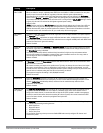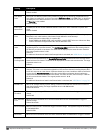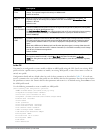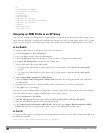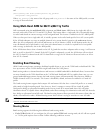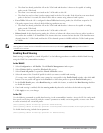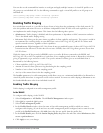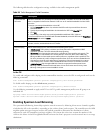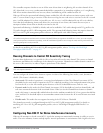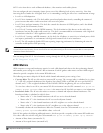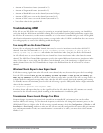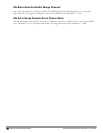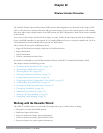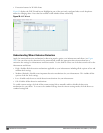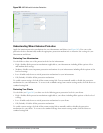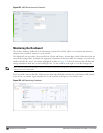
The controller compares whether or not an AP has more clients than its neighboring APs on other channels. If an
AP’s client load is at or over a predetermined threshold as compared to its immediate neighbors, or if a neighboring
Dell AP on another channel does not have any clients, load balancing will be enabled on that AP.
When an AP has the spectrum load balancing feature enabled, the AP will send an association response with error
code 17 to new clients trying to associate. If the client receiving the error code tries to associate to the AP a second
time, it will be admitted. If a client is rejected by two APs in a row, it will be admitted by any AP on its third try.
Note that the load balancing feature only affects the association of new clients; this feature does not reject or
attempt to balance clients that are already associated to the AP.
Spectrum load balancing is disabled by default, and can be enabled for 2.4G traffic through an 802.11g profile or for
5G traffic through an 802.11a RF management profile. The spectrum load balancing feature also requires that the
802.11a or 802.11g RF management profiles reference an ARM profile with ARM scanning enabled.
NOTE: The spectrum load balancing feature available in ArubaOS 3.4.x and later releases completely replaces the
AP load balancing feature available earlier versions of ArubaOS. When you upgrade to ArubaOS 3.4.x or later, you must manually
configure the spectrum load balancing settings, as the AP load balancing feature can no longer be used, and any previous AP load
balancing settings will not be preserved.
For details on modifying 802.11a or 802.11g RF management profiles, refer to "Working with Mesh High
Throughput SSID Profiles " on page 455 .
Reusing Channels to Control RX Sensitivity Tuning
In some dense deployments, it is possible for APs to hear other APs on the same channel. This creates co-channel
interference and reduces the overall usage of the channel in a given area. Channel reuse enables dynamic control over
the receive (Rx) sensitivity in order to improve spatial reuse of the channel.
NOTE: The channel reuse feature applies to non-DFS channels only. It is internally disabled for DFS channels and is does not affect
DFS radar signature detection.
You can configure the channel reuse feature to operate in either of the following three modes;
static, dynamic or
disable
. (This feature is disabled by default.)
l Static mode: This mode of operation is a coverage-based adaptation of the Clear Channel Assessment (CCA)
thresholds. In the static mode of operation, the CCA is adjusted according to the configured transmission power
level on the AP, so as the AP transmit power decreases as the CCA threshold increases, and vice versa.
l Dynamic mode: In this mode, the Clear Channel Assessment (CCA) thresholds are based on channel loads, and
take into account the location of the associated clients. When you set the Channel Reuse feature to dynamic
mode, this feature is automatically enabled when the wireless medium around the AP is busy greater than half the
time, and the CCA threshold adjusts to accommodate transmissions between the AP its most distant associated
client.
l Disable mode: This mode does not support the tuning of the CCA Detect Threshold.
The channel reuse mode is configured through an 802.11a or 802.11g RF management profile. For details on
modifying 802.11a or 802.11g RF management profiles, refer to “Mesh High-Throughput SSID Profiles” on
page465.
Configuring Non-802.11 for Noise Interference Immunity
When an AP attempts to decode a non-802.11 signal, that attempt can momentarily interrupt its ability to receive
traffic. The noise immunity feature can help improve network performance in environments with a high level of non-
DellPowerConnectW-SeriesArubaOS6.2 | User Guide AdaptiveRadioManagement (ARM) | 360



